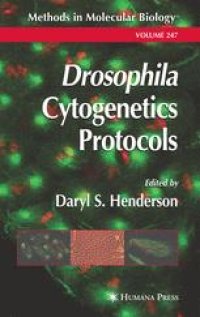
Ebook: Drosophila Cytogenetics Protocols
Author: Daryl S. Henderson (ed.)
- Tags: Animal Genetics and Genomics
- Series: Methods in Molecular Biology 247
- Year: 2004
- Publisher: Humana Press
- Edition: 1st
- Language: English
- pdf
Probably no single experimental organism has contributed as much to our understanding of the structure, function, and mechanism of transmission of eukaryotic chromosomes as has the fruit fly, Drosophila melanogaster. In Drosophila Cytogenetics Protocols, leading drosophilists describe, in step-by-step detail, all the essential techniques for studying Drosophila chromosomes and suggest new avenues for scientific exploration. General areas covered include analyses of nuclei and chromosomes in spermatogenesis and oogenesis, fluorescence-activated cell sorting of ovarian follicle cells, analyses of nuclear division cycles in embryos, and analyses of programmed cell death. In addition, there are conventional light-, electron-, and immunofluorescence-microscopic analyses of polytene chromosomes; cytological analyses of larval brains, imaginal discs, and histoblasts; and nonfluorescent and fluorescent in situ hybridization (FISH) to both polytene and mitotic chromosomes. A cutting-edge combined FISH and immunolocalization protocol will be important for discovering how DNA sequence influences higher-order chromosome architecture and ultimately gene expression. Each readily reproducible protocol offers a background introduction, equipment and reagent lists, and tips on troubleshooting and avoiding pitfalls.
Readily accessible and highly practical, Drosophila Cytogenetics Protocols provides a comprehensive cytogenetics laboratory manual for Drosophila investigators, one that is suitable not only for novices, but also highly informative for seasoned investigators.
Probably no single experimental organism has contributed as much to our understanding of the structure, function, and mechanism of transmission of eukaryotic chromosomes as has the fruit fly, Drosophila melanogaster. In Drosophila Cytogenetics Protocols, leading drosophilists describe, in step-by-step detail, all the essential techniques for studying Drosophila chromosomes and suggest new avenues for scientific exploration. General areas covered include analyses of nuclei and chromosomes in spermatogenesis and oogenesis, fluorescence-activated cell sorting of ovarian follicle cells, analyses of nuclear division cycles in embryos, and analyses of programmed cell death. In addition, there are conventional light-, electron-, and immunofluorescence-microscopic analyses of polytene chromosomes; cytological analyses of larval brains, imaginal discs, and histoblasts; and nonfluorescent and fluorescent in situ hybridization (FISH) to both polytene and mitotic chromosomes. A cutting-edge combined FISH and immunolocalization protocol will be important for discovering how DNA sequence influences higher-order chromosome architecture and ultimately gene expression. Each readily reproducible protocol offers a background introduction, equipment and reagent lists, and tips on troubleshooting and avoiding pitfalls.
Readily accessible and highly practical, Drosophila Cytogenetics Protocols provides a comprehensive cytogenetics laboratory manual for Drosophila investigators, one that is suitable not only for novices, but also highly informative for seasoned investigators.
Probably no single experimental organism has contributed as much to our understanding of the structure, function, and mechanism of transmission of eukaryotic chromosomes as has the fruit fly, Drosophila melanogaster. In Drosophila Cytogenetics Protocols, leading drosophilists describe, in step-by-step detail, all the essential techniques for studying Drosophila chromosomes and suggest new avenues for scientific exploration. General areas covered include analyses of nuclei and chromosomes in spermatogenesis and oogenesis, fluorescence-activated cell sorting of ovarian follicle cells, analyses of nuclear division cycles in embryos, and analyses of programmed cell death. In addition, there are conventional light-, electron-, and immunofluorescence-microscopic analyses of polytene chromosomes; cytological analyses of larval brains, imaginal discs, and histoblasts; and nonfluorescent and fluorescent in situ hybridization (FISH) to both polytene and mitotic chromosomes. A cutting-edge combined FISH and immunolocalization protocol will be important for discovering how DNA sequence influences higher-order chromosome architecture and ultimately gene expression. Each readily reproducible protocol offers a background introduction, equipment and reagent lists, and tips on troubleshooting and avoiding pitfalls.
Readily accessible and highly practical, Drosophila Cytogenetics Protocols provides a comprehensive cytogenetics laboratory manual for Drosophila investigators, one that is suitable not only for novices, but also highly informative for seasoned investigators.
Content:
Front Matter....Pages i-xiii
Back Matter....Pages 1-43
....Pages 45-75